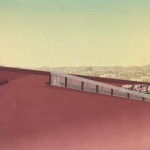
The “Great mosque of al-Mutawakkil” in Samarra, (Iraq), was commissioned in 848 and built in 851 under Abbasid Caliph Al-Mutawakkil after his father moved to Samarra from Baghdad to establish a new capital. At the time it was one of the largest mosques in the world and could gather up to 80,000 faithful. The structure is composed by a large rectangle of almost 38,000 square metres with the 3:2 proportions typical of many mosques, enclosed in bastions walls 2.65m thick with forty-four semi-circular towers. The building stood within an outer enclosure of 444 x 376 meters, encompassing a total area of 17 hectares which enabled even more believers to attend functions.
Its minaret, the Malwiya Tower, is a vast cone with a spiral ramp 52 meters high and 33 metres wide, standing on its own on the Northside: its peculiar design makes it a unique example of this type. While the wall still stands, little remains of the interiors which have been largely damaged and despoiled for the materials to be reused elsewhere. Thanks to the archaeological excavations we know that the building had 17 aisles and its walls were panelled with mosaics of dark blue glass and cut marble panels. The Mosque could be entered through sixteen gates to reach the interior sequence of pillars which mediate the passage from the outer walls to the central prayer hall. The pillars were distributed on a dense grid and supported a teakwood roof. The mosque was partially destroyed in 1278 after the Hulagu Khan invasion of Iraq. In 2005, the top of the Malwiya minaret was damaged by a bomb.








Further reading:
Islamic Arts





Can you please tell me source of the first image you have posted on The Field and the Wall: The Great Mosque of Samarra.
Thank you!
Hello Tanaz, we are sorry but we do not have that information,
thanks for reading,
FL